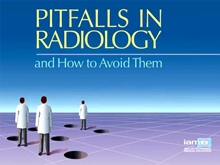Viewing Information
Program Description
Effective Date: March 1, 2014 Expiration Date: April 1, 2017
Format: Self Instructional - Audio Visual
Pitfalls... Every radiologist has fallen victim to one or more of these.
They tend to fall into certain patterns, often with important clinical implications. We may miss or misinterpret findings based on faulty technique, imaging protocol, or lack of familiarity with criteria for distinguishing among similarly appearing lesions.
Faculty is made up of experienced radiologists who have spent years observing the common mistakes made by trainees, other radiologists and themselves. They will discuss the importance of decision-support tools as an aid to providing an accurate and specific diagnosis or limited differential diagnosis. They will present clues to improve imaging and viewing protocols that will reduce diagnostic errors. And they will present the keys for recognizing and avoiding common and critical Pitfalls in Radiology.
Pitfalls in Radiology presents the most common and important pitfalls in the chest, abdomen, pelvis, breast and musculosketeal areas. Ample time will be provided for questions and discussions among the attendees and lecturers.
Learning Objectives:
At the completion of this program participants will have learned:
- The financial and health costs of overly vague or incorrect differential diagnoses, and other interpretive errors.
- How to use decision-support tools that can help radiologists make more accurate diagnoses.
- How to optimize those imaging and viewing protocols that may impair the ability of radiologists to make accurate and clinically useful diagnoses.
Conference Chair
Michael P. Federle, MD, FACR
Professor and Associate Chair for Education Department of Radiology
Stanford University Medical Center, Stanford, CA
Faculty
Genevieve L. Bennett, MDAssistant Professor Todd M. Blodgett, MDPresident, FRG Molecular Imaging Giles Boland, MDAssociate Professor of Radiology, HMS |
Jafi Lipson, MDAssistant Professor Nancy M. Major, MDDirector of Imaging |
Ali Shirkhoda, MD, FACRClinical Professor of Radiology W. Richard Webb, MDProfessor Emeritus of Radiology |
Accreditation
The Institute for Advanced Medical Education is accredited by the Accreditation Council for Continuing Medical Education (ACCME) to provide continuing medical education for physicians. The Institute for Advanced Medical Education designates this live activity for a maximum of 12 AMA PRA Category 1 Credits™. Physicians should only claim credit commensurate with the extent of their participation in the activity. Participants will receive up to 2 SAMs for participating in the designated SAM sessions. Certificate will indicate modality credits earned.
Table of Contents
1 - Introduction |
Michael P. Federle, MD, FACR |
2 - Errors in Radiology: Scope of the Problem |
Giles Boland, MD |
3 - Pitfalls: Genitourinary |
Ali Shirkhoda, MD, FACR |
4 - Pitfalls: Breast Imaging, Part 1 |
Jafi Lipson, MD |
5 - Pitfalls: Adrenal, Pancreas and Spleen |
Ali Shirkhoda, MD, FACR |
6 - Questions and Discussion |
Faculty Panel and Attendees |
7 - Pitfalls: Female Pelvis, Part 1 |
Genevieve L. Bennett, MD |
8 - Pitfalls: Breast Imaging, Part 2 |
Jafi Lipson, MD |
9 - Pitfalls: Female Pelvis, Part 2 |
NGenevieve L. Bennett, MD |
10 - Pitfalls: Gut & Mesentery |
Michael P. Federle, MD, FACR |
11 - Questions and Discussion |
Faculty Panel and Attendees |
12 - Pitfalls: PET-CT, Part 1 |
Todd M. Blodgett, MD |
13 - Pitfalls: Chest, Part. 1 |
W. Richard Webb, MD |
14 - Pitfalls: Musculoskeletal, Part 1 |
Nancy M. Major, MD |
15 - Pitfalls: PET-CT, Part 2 |
Todd M. Blodgett, MD |
16 - Questions and Discussion |
Faculty Panel and Attendees |
17 - Pitfalls: Chest, Part. 2 |
W. Richard Webb, MD |
18 - Pitfalls: Liver |
Michael P. Federle, MD, FACR |
19 - Pitfalls: Musculoskeletal, Part. 2 |
Nancy M. Major, MD |
20 - Reducing Diagnostic Errors: Peer Review & Decision Support |
Giles Boland, MD |
21 - Questions and Discussion |
Faculty Panel and Attendees |
Target Audience
The target audience for this program is Radiologists and Related Imaging Professionals.
